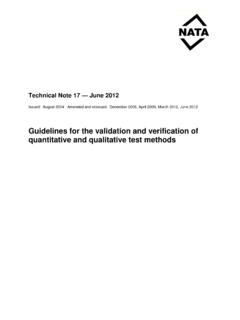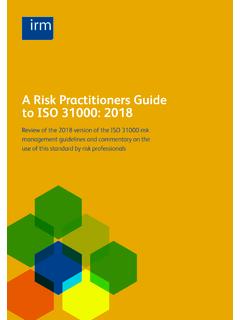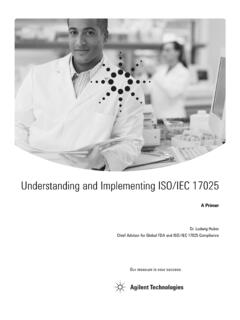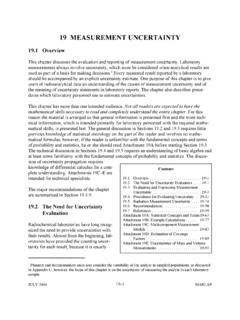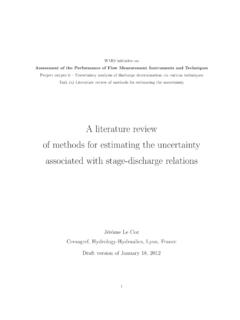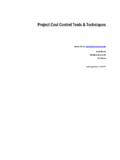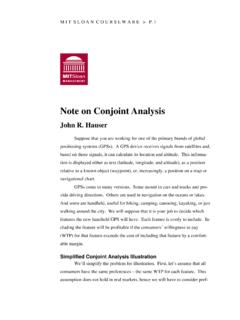Transcription of The Expression of Uncertainty in Testing
1 LAB 12 Z The Expression of Uncertainty in testingEdition 1 Z October 2000 Page 1 of 13 SectionPageContentsThe Expression ofUncertainty in Testing [UKAS Publication ref: LAB 12]1 Introduction32 Definitions33 Reporting and evaluation of uncertainty34 Reasons for evaluating uncertainty45 General principles46 Sources of uncertainty57 estimation of uncertainty68 Summary of the steps in estimating uncertainty89 Method of stating results910 Assessment of compliance with specification1011 Proficiency Testing and measurement audit12 Appendix ADefinitions of terms13 LAB 12 ZZ The Expression of Uncertainty in testingPage 2 of 13 Edition 1 Z October 2000 LAB 12 ZZEdition 1 ZZOctober 2000 United Kingdom Accreditation Service21 47 High StreetFelthamMiddlesex TW13 4 UNUKTel:020 8917 8555 Fax:020 8917 8500 United Kingdom Accreditation Service 2000 About the United Kingdom Accreditation ServiceThe United Kingdom Accreditation Service (UKAS) is recognised by theUKGovernment as the national body responsible for assessing and accreditingthe competence of organisations in the fields of calibration, Testing , inspectionand certification of systems, products and 12 Z The Expression of Uncertainty in testingEdition 1 Z October 2000 Page 3 of general requirements for the estimation and reporting of Uncertainty inaccredited laboratories are given in ISO/IEC 17025.
2 General guidance on howthey may be met when estimating and reporting Uncertainty in Testing isgiven in this publication. UKAS Publications, M4 lists some other publicationsgiving guidance on evaluation of general approach to evaluating and expressing Uncertainty in testingoutlined here is based on the recommendations produced by the InternationalCommittee for Weights and Measures (CIPM), as described in the Guide to theExpression of Uncertainty in Measurement, 1993, ISO Geneva. (The Guide). the interests of keeping to a general, descriptive format, exceptions, specialcases and qualifying remarks have not been dealt with in detail and equationshave not been included. The Guide should be consulted for equations andsymbols, and when needing to resolve special difficulties that may arise inspecific of terms are given in alphabetical order in Appendix A.
3 Definedterms are printed in bold at the first appropriate occurrence in the main bodyof the and evaluation of requirements of ISO/IEC 17025 distinguish between the need forreporting and the need for evaluation of Uncertainty of is required when information on Uncertainty is relevant to thevalidity or application of the test results, when the client requires it or whenthe Uncertainty affects compliance with a specification of Uncertainty of measurement is required for calibrations,including those performed in house, and procedures for estimatinguncertainty of measurement of tests are needed and need to be complexity of tests may in some cases preclude a rigorous evaluation ofuncertainty. In such cases, at least a list of the potential contributors touncertainty should be made and should include reasonable estimates of themagnitude of each component Uncertainty .
4 These estimates may be based onprevious experience and make use of data from method validation and othersources, such as quality control data, proficiency test data and round robintest results. It is recommended that an example be produced in which theoverall Uncertainty of the result for that test method is cases where a well-recognised test method specifies limits to the values ofmajor sources of Uncertainty of measurement and specifies the form ofpresentation of the results the requirement to estimate Uncertainty ofmeasurement can be considered to have been satisfied by following the testmethod and its reporting 12 ZZ The Expression of Uncertainty in testingPage 4 of 13 Edition 1 Z October 20004 Reasons for evaluating Expression of the Uncertainty of a result allows realistic comparison ofresults from different laboratories, or within a laboratory or with referencevalues given in specifications or standards.
5 This information can oftenprevent unnecessary repetition of Uncertainty of the result of a test may need to be taken into account by acustomer when interpreting data. For example, comparison of results fromdifferent batches of material will not indicate real differences in properties orperformance if the observed differences could simply be accounted for by theuncertainty of the evaluation [or at least a full consideration] of the components, includingrandom effects from human operators, that contribute to the overalluncertainty of a measurement or test result provides a means of establishingthat the test procedure, including the metrological characteristics of theequipment used, will allow valid measurements and results to be consideration of Uncertainty components also indicates aspects of a test towhich attention should be directed to improve assessment of the factors influencing the result and of theuncertainty based on the understanding of the principles of the method andpractical experience of its application can be a key part of method objective of a measurement is to determine the value of the measurand, the specific quantity subject to measurement.
6 When applied to Testing , thegeneral term measurand may cover many different quantities, thestrength of a material, the concentration of an analyte, the level of emissionsof noise or electromagnetic radiation, the quantity of micro-organisms. Ameasurement begins with an appropriate specification of the measurand, thegeneric method of measurement and the specific detailed general, no measurement or test is perfect and the imperfections give riseto error of measurement in the result. Consequently, the result of ameasurement is only an approximation to the value of the measurand and isonly complete when accompanied by a statement of the Uncertainty of of measurement may have two components, a random component anda systematic component. Uncertainty arises from random effects and fromimperfect correction for systematic errors arise from random variations of the observations (randomeffects).
7 Every time a measurement is taken under the same conditions,random effects from various sources affect the measured value. A series ofmeasurements produces a scatter around a mean value. A number of sourcesmay contribute to variability each time a measurement is taken, and theirLAB 12 Z The Expression of Uncertainty in testingEdition 1 Z October 2000 Page 5 of 13influence may be continually changing. They cannot be eliminated butincreasing the number of observations and applying statistical analysis mayreduce the Uncertainty due to their errors arise from systematic effects, an effect on ameasurement result of a quantity that is not included in the specification ofthe measurand but influences the result. These remain unchanged when ameasurement is repeated under the same conditions, and their effect is tointroduce a displacement between the value of the measurand and theexperimentally determined mean value.
8 They cannot be eliminated but maybe reduced, a correction may be made for the known extent of an errordue to a recognised systematic Guide has adopted the approach of grouping Uncertainty components intotwo categories based on their method of evaluation. Type A evaluation isdone by calculation from a series of repeated observations, using statisticalmethods. Type B evaluation is done by means other than that used for TypeA . For example, by judgement based on data in calibration certificates,previous measurement data, experience with the behaviour of theinstruments, manufacturers specifications and all other relevant of Uncertainty are evaluated by the appropriate method andeach is expressed as a standard deviation and is referred to as a standard Uncertainty components are combined to produce an overallvalue of Uncertainty , known as the combined standard expanded Uncertainty is usually required to meet the needs of industrial,commercial, health and safety, or other applications.
9 It is intended to providea greater interval about the result of a measurement than the standarduncertainty with, consequently, a higher probability that it encompasses thevalue of the measurand. It is obtained by multiplying the combined standarduncertainty by a coverage factor, k. The choice of factor is based on thecoverage probability or level of confidence required (see paragraph ).6 Sources of are many possible sources of Uncertainty in Testing , including:(a)Incomplete definition of the test; the requirement is not clearly described,eg the temperature of a test may be given as room temperature ;(b)Imperfect realisations of the test procedure; even when the testconditions are clearly defined it may not be possible to produce therequired conditions;(c)Sampling - the sample may not be fully representative;(d)Inadequate knowledge of the effects of environmental conditions on themeasurement process, or imperfect measurement of environmentalconditions;(e)Personal bias in reading analogue instruments;LAB 12 ZZ The Expression of Uncertainty in testingPage 6 of 13 Edition 1 Z October 2000(f)Instrument resolution or discrimination threshold, or errors in graduationof a scale.
10 (g)Values assigned to measurement standards (both reference and working)and reference materials;(h)Changes in the characteristics or performance of a measuring instrumentsince the last calibration;(i)Values of constants and other parameters used in data evaluation;(j)Approximations and assumptions incorporated in the measurementmethod and procedure;(k)Variations in repeated observations made under apparently identicalconditions - such random effects may be caused by, for example: short-term fluctuations in local environment, eg temperature, humidity and airpressure; variability in the performance of the sources are not necessarily independent and, in addition, unrecognisedsystematic effects may exist that cannot be taken into account but contributeto error. (The existence of such effects may sometimes be evident fromexamination of the results of an inter-laboratory comparison programme.)


